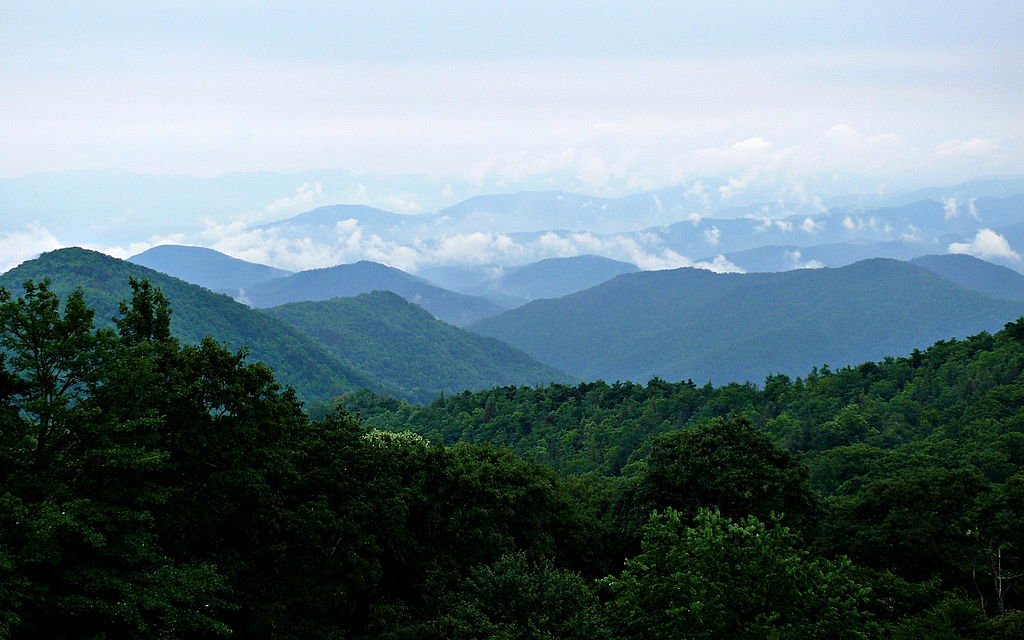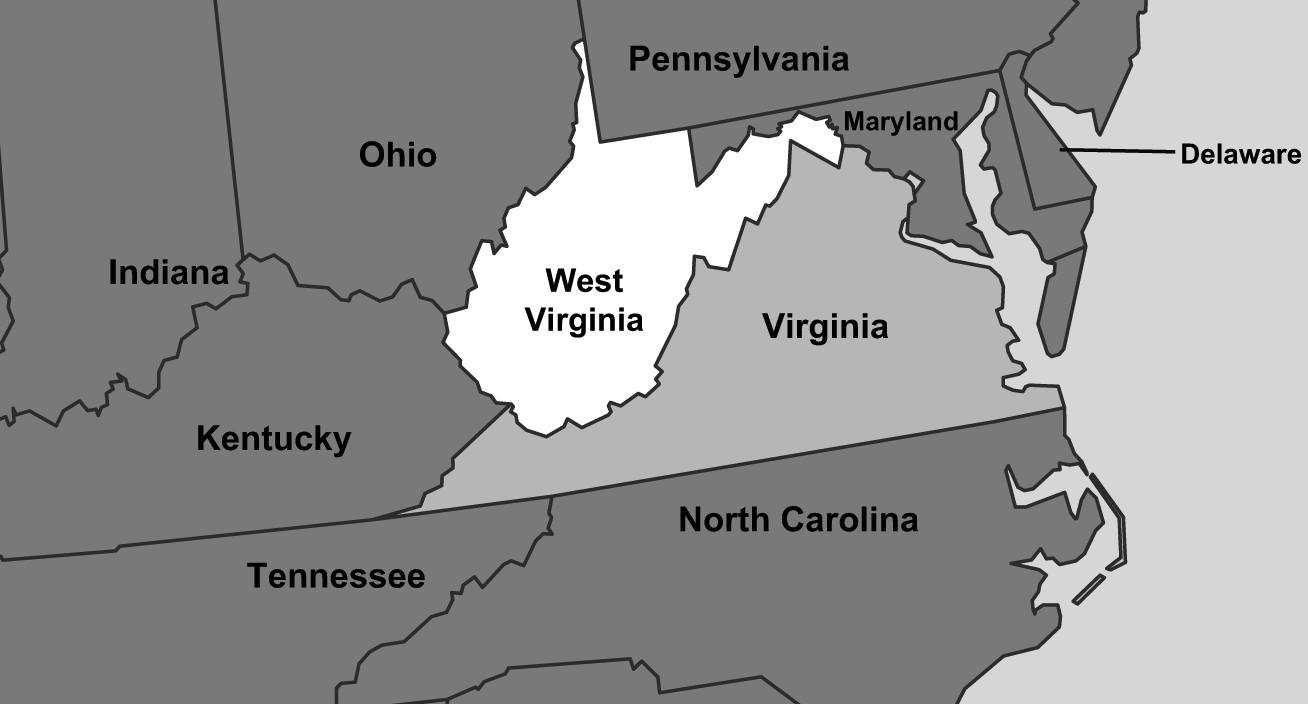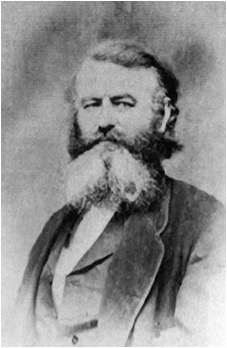WEST VIRGINIA
Almost Heaven, West Virginia
Blue Ridge Mountains
Shenandoah River
—John Denver, Take Me Home, Country Road
We came from the West Virginia coalmines
And the Rocky Mountains and the western skies
And we can skin a buck; we can run a trout line
And a country boy can survive
Country folks can survive
—Hank Williams, Jr., Country Boy Can Survive
Mountains
West Virginia is virtually synonymous with “mountains.” We think of the Alleghany and the Blue Ridge Mountains and the pioneers who explored them all the way to Kentucky. We think of the coal mines that stretch from West Virginia’s western valleys north into Pennsylvania. West Virginia shares its history with those states that share its mountains. Of course we also think of John Denver—almost heaven, mountain mama, and all that. What we tend not to associate with West Virginia are the colonial plantation owners of its parent state, Virginia.

West Virginia’s name says a lot. Virginia, originally the English name for the whole eastern seaboard, was accustomed to being divided. During colonial times, chunks were broken off routinely to create new colonies, and later territories, all around it. What is different about West Virginia is that it divided itself from Virginia during the Civil War, after the eastern, midwestern, and southeastern states were well established. By 1860 the borders in America’s eastern region seemed firmly established. But Virginia had a natural dividing line—the mountains that separated its genteel farmers from its western settlers. By the time war broke out between the states, that natural division caused irreconcilable differences.
“West” Virginia tells the story, not of consensual division of a state, but of secession. North and South Carolina and North and South Dakota all share names, connoting correctly the mutually beneficial divisions that pulled them apart from one another. But West Virginia, we can tell by what we call it, is the product of reluctant division. Virginia remained Virginia, but those who disagreed so strongly with its secession from the Union in 1861 broke off. They would be a new state with a new name, but they considered themselves Virginians, too, and deeply regretted that they could not keep the name. That however, was the price of acting on their collective conscience.
West, Western, Transmontane Virginia
The bicentennial history of West Virginia written by John Alexander Williams contains the following footnote:
“Before West Virginia became a state in 1863, the terms “western Virginia” and “West Virginia” were used interchangeably to describe the entire western half of Virginia, that is, all Virginia territory lying west of the Blue Ridge Mountains. The new state, however, took about two-thirds of this territory, which creates a problem of nomenclature...”
And not a small problem. Williams continues,
“...when writing about present West Virginia in its pre-statehood days. In this volume, “western Virginia” and “West Virginia” are used interchangeably, but only to refer to that territory now included in West Virginia. Traditional western Virginia (present West Virginia plus present west-central and southwestern Virginia) is called “transmontane Virginia.”1
At least part of what Williams is talking about is that West Virginia isn’t exactly west of Virginia. It is northwest of Virginia, and truth be told, more north than west. That is, all of West Virginia is north of Virginia, but all of Virginia isn’t east of West Virginia. He is also saying that most, but not all, of Virginia west of the Allelgheny Mountains became West Virginia. Okay, maybe Williams says it better, but the point is it can be a little difficult to talk about.
The geography is important, though, because long before the Civil War the state’s physical features were dividing it. The wealthy plantation owners in the east were making all the rules, such as those that required substantial land ownership before a person could vote. This excluded the majority of settlers in the mountains who did not own the land they lived on, or if they did, it wasn’t enough. There were also problems of taxation, the easterners making it easier on themselves by taxing their slaves at only ten percent of their recorded value, creating a larger tax burden for those in the west. Still, these were political problems that the state was trying to work through.

In the 1820s and 30s rumblings of division began in earnest. Abolition began as a political movement, and western Virginia was a hotbed of activism. Businessmen of the region supported abolition, not entirely on moral grounds, but largely because they felt slavery was taking jobs away from whites in the state−whites who desperately needed work. But separation from Virginia was still a drastic concept, and so to appease the westerners and quiet their calls for separation, the General Assembly worked to improve the representation for those across the Alleghanies, and build up the western infrastructure.
Kanawha?
The election of Abraham Lincoln divided the state of Virginia just as cleanly as it divided the rest of the nation, and the process of creating a new state from the western counties moved at lightning speed, at least compared to other, more conventional state-making efforts. On April 17, 1861, the Virginia legislature voted to submit a secession bill for popular vote, and the delegates from the western part of the state walked out of the convention. Two months later, when the Civil War fighting was underway in earnest, those western delegates met to form the Restored Government of “New” Virginia, which was quickly recognized by Lincoln as the legitimate government of the state. In August, the Second Wheeling Convention approved an ordinance creating a new state out of portions of Virginia, and named it Kanawha.
“Kanawha” was the name of two rivers, as well as a large county, central to the proposed new state. The name derived from an Indian word, probably from an Algonquin-speaking tribe—Delaware or Shawnee perhaps. The true derivation is unclear because when the earliest white settlers arrived in West Virginia, there were almost no natives living there. Early explanations for this dearth of Indian settlements centered on the decimation of natives by disease, but the region was also fought over, and the Iroquois to the north had asserted their dominance and driven out the tribes who had once called the region home. As near as anyone can tell, the name “Kanawha” meant “place of white stone” in reference to the large salt deposits in the region.
The Debate
On November 26, the Constitutional Convention for what would become West Virginia began, and about a week into it, on December 3, the state’s name was debated. Harmon Sinsel, a carpenter from Taylor County, was the first to object to the new, native-language-based name. His comments were passionate and illustrated the heartache of the times. He said, in part, “I am a Virginian; I was born and raised in Virginia, and I have ever been proud of the name. I admit that Virginians have done wrong—that many of them in this rebellion have disgraced themselves; but that has not weaned me from the name.”2

His objections were followed by a more pragmatic one. An attorney named Peter Van Winkle pointed out that the name already applied to a county in the new state, and that it would be imprudent for the state to share the county’s name. He highlighted the problems of postal delivery and the fact that no other state bore the name of any of its own counties. (Which wasn’t true, and Van Winkle was corrected later in the debate.)
The discussion was lengthy. The delegate from Kanawha argued that the name had already been decided upon, and that this body had no right to change it. Another attorney rebutted this, saying that his constituents who had voted for the creation of a new state had objected to the name Kanawha and had requested that he attempt in this convention to have it changed. The arguments were full of protestations of loyalty to the Union and the hope of finding a name that would convey that sentiment. Eventually, the names “Western Virginia” and “New Virginia” were proposed, prompting a passionate response from Daniel Lamb of Wheeling:
“Sir, I have been an inhabitant of western Virginia for thirty odd years. During that time what have we received here but oppression, and outrage I may say, from the State of Virginia... Are we still to retain the name? Are we to change everything in Virginia but the name? Shall we make a change in everything—in all the essentials—and yet stick upon this slight matter? Shall we proclaim in the very act which this Convention is now about to adopt that we feel grateful for the favor of the State of Virginia as heretofore bestowed upon us? No, gentlemen, no! I want to cut loose from these recollections. I want to have the new State, not merely in substance, but even in name.”
The discussion lightened up, however, when a delegate admitted that one of the objections he had to “Kanawha” was its difficult spelling, and another suggested that “Loyal Virginia” might be an appropriate compromise. Peter Van Winkle cut to the heart of the matter:
“If you make an agreement with eastern Virginia that after the division takes place, one is to be called East and the other West, or one is to be called Old Virginia and the other New, there might be less impropriety in it; for then it would indicate a division of territory, but, sir, under any circumstances they are to retain the name. They are to be Virginia and we are to be 'Little Virginia,' or 'New Virginia,' or 'West Virginia,' or some other soubriquet which is to degrade us in comparison with them.”
“West Virginia” was eventually proposed by Chapman Stuart, a 41-year-old attorney from Doddridge County, saying “...It is familiar all over this broad land of our country—West Virginia. Something attaches to the name that ennobles us in the eyes of the country.”
There were other names proposed, and the debate finally came to a vote. The matter of a name was decided with the following vote count:
“Augusta” - 1
“Alleghany” - 2
“Western Virginia” - 2
“Kanawha” - 9
“West Virginia” - 30
West Virginia
The U.S. Constitution states that any portion of a state wishing to secede from its “parent” state must receive permission from that parent. This was obviously not going to happen, as the secession would occur during the Civil War, but the problem was solved rather easily. Because Lincoln recognized the Restored Government of Virginia—the one formed by western Virginians—as the state’s legitimate government, the officials of eastern Virginia technically had no say in the matter. The Restored Government essentially granted itself permission to secede, and the matter was settled.
In early July of 1862, the U.S. Senate debated the admission of West Virginia to the Union. They focused mainly on matters of slavery and did not discuss the name, though some of the senators clearly struggled with using its new moniker, calling it instead “Western Virginia” or “Northwestern Virginia” at times. The vote to admit West Virginia was 23 to 17, and so it became the 35th state in the Union—provided, of course, that the Union was ultimately preserved.
The Enabling Act was signed by President Abraham Lincoln on New Year’s Eve, December 31, 1862, but that was not the final step in the process. The Enabling Act provided for statehood on the condition that the new state’s constitution contain language that would eventually abolish slavery. The West Virginia legislature went back to work and added this provision. Finally, Lincoln read a proclamation on April 20, 1863, that would confer statehood in sixty days time. Thus, the official date of statehood for West Virginia is June 20, 1863.
End Notes
1. Williams, John Alexander, West Virginia: A Bicentennial History, (New York, 1976), p. 3
2. West Virginia Archives and History, “’What’s in a name?’ The naming of West Virginia,” A State of Convenience: The Creation of West Virginia, an On-Line Exhibit, http://www.wvculture.org/history/statehood/statename.html, last accessed 11/5/09.